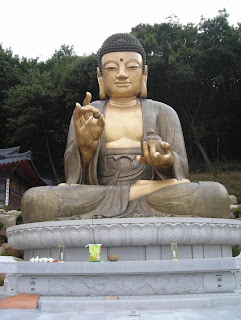
Yesterday I went on a hike with all my co-workers near were I live on Shimhak Mountain
Now at the trail head were we began and finished there was a Buddhist temple and the largest statue of the Buddha that I have ever seen in person. I have no idea how tall it was? My guess would be around 40 feet (just over12 meters). As I looked at the statue I saw that there were multiple people circling it with there palms pressed together. It became clear to me that they were praying and my co-teacher soon confirmed that. I watched for awhile and they all moved at the same steady pace around the Buddha being very intentional with where they placed their feet as if they knew exactly where they were supposed to step. There were also mats near the statues which people took and laid down in front of the Buddha at which point they bowed down with their face completely touching the ground while raising their hands with their palms facing up. After a short time they would stand all the way up, raise their head and look at the statue and then do it all over again. They would repeat this same action multiple times.
My teacher then showed me that on the wall surrounding the entire courtyard of the temple there were individual pieces of wood all identical in size with Korean writing painted on them. They were hanging in perfect lines across the entire length of the wall with five or six rows from top to bottom. My co-teacher explained that people wrote their prayers and petitions to the Buddha for various things on those pieces of wood and then hung them on the wall. He read me some of them and most were simple prayers asking for different things such as the health of a loved one, help on a test and there was even one were a little girl had asked that she would be able to stop fighting with her brother. I walked over to the temple itself and looked inside and saw that there were multiple statues of the Buddha inside. There was one large statue in the center surrounded by smaller ones and just like I had seen outside by the large Buddha there were people bowing down in front of the statues, faces touching the ground with their hands lifted in the air palms up.
One of the teachers I was with actually walked around the statue and wrote a prayer on one of the pieces of wood to leave hanging at the temple. As I walked around looking many of the people there smiled at me as they exited the temple offering me a sense of calm as I observed. They were acting upon their beliefs and I could see as they left the temple that they looked refreshed and at peace.
As I contemplated my surroundings I found myself standing in a part of the world that for most of its history had been untouched by Christianity. I was staring at a beautiful temple surrounded by carefully constructed gardens and a giant statue honoring the Buddha but what stood out was the genuineness of the people I watched as they participated in religious rituals that have been practiced over multiple millennia and, which were vital in shaping who they were as people both culturally and individually. And this brief moment reminded me why I have rejected Christianity’s claim of religious superiority as expressed in Christ’s words, “I am the way, and the truth, and the life. No one comes to the father except through me,” (1) because it made one simple fact crystal clear: these people, like their ancestors before them, don’t need Jesus or his God to live good, meaningful lives.
(1) John 14:6-The Gospel of John is of little value in constructing a picture of who the historical Jesus really was and can’t be relied upon to determine what Jesus’ actual words or deeds were. The book is the theology of the author placed into the mouth of Jesus. It’s all but certain that the historic Jesus never said these words.

I've heard similar stories from friends returning from Japan. It's true that the way modern (last couple hundred years) Christianity has applied their understanding of the Gospels leaves no room for the religion of one's own ancestors, but this wasn't always true. The early Church, once freed by Constantine's seal of approval, began to expand - but they absorbed the cultures and religions they encountered, instead of fighting them. I think, in a way, these early evangelicals understood that the people they encountered didn't "need" Jesus in the way the proselytizers originally supposed, and so molded the explanation of Jesus and God to fit the cultural heritage of those they met. A good example of this is Saunders' "Gospel for Asia" (you'd enjoy it, I think!).
ReplyDeleteGood to hear from you again. I can't say I fully agree but as always thanks for your good ideas and insights.
ReplyDeleteYou're probably right in terms of intent; I doubt the Church (during its assimilation stage) acted as it did in the interest of protecting and maintaining the old myths and superstitions and rites, but instead in its own interest. But the outcome was still the same, for the most part.
ReplyDelete